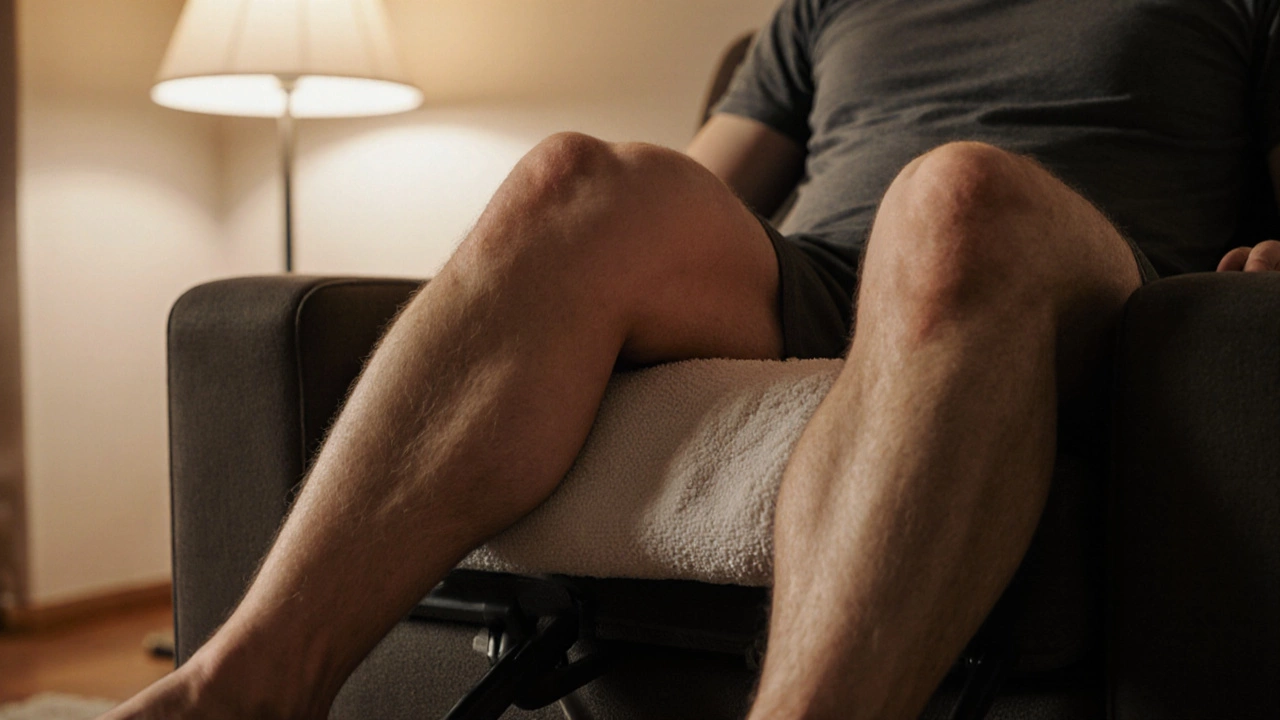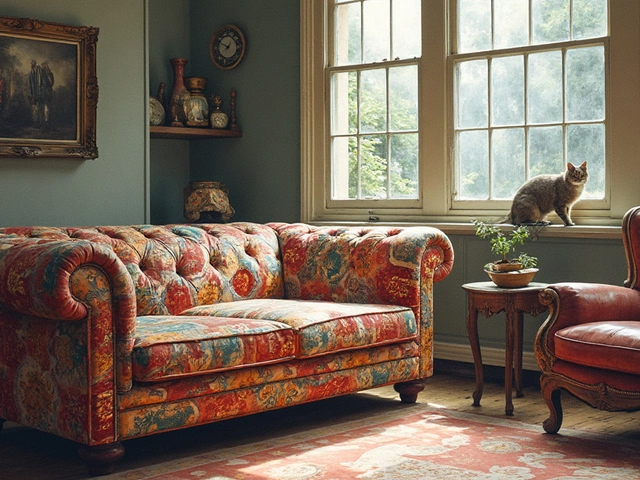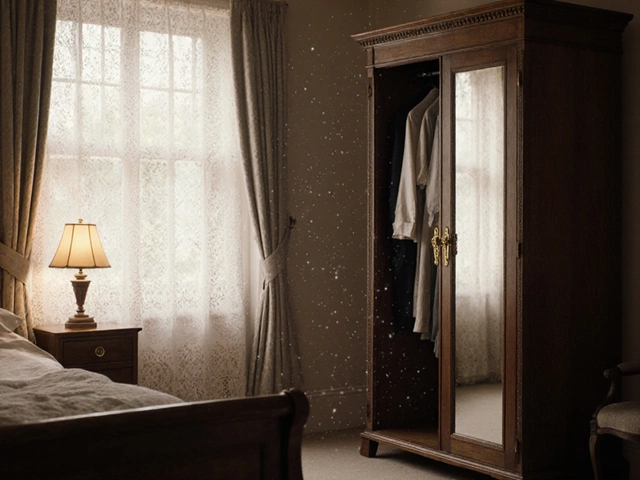You sink into your recliner after a long day, feet up, back supported-except your legs start to ache. It’s not just in your head. Thousands of people experience this exact problem, and it’s rarely about the chair being broken. More often, it’s about how your body is positioned, or not positioned, inside it.
Your legs aren’t getting the right support
Most recliners are designed to cradle your back and head, not your legs. When you sit back and lift your footrest, your knees might be bent too sharply, or your calves could be dangling off the edge. Either way, your leg muscles and joints aren’t resting-they’re straining.Look at your legs when you’re seated. If your knees are higher than your hips, or if your calves aren’t fully supported from knee to heel, your hamstrings and calf muscles are working overtime just to hold your legs in place. That’s why you feel that deep, dull ache after 20 minutes. It’s not the chair’s fault-it’s the mismatch between your anatomy and its design.
A 2023 study from the University of Leeds found that 68% of people who reported leg pain while using recliners had their footrest set too low. Their feet weren’t touching the surface, so their legs were hanging. Another 22% had the footrest too high, forcing their knees into a 110-degree angle or tighter. The ideal position? Knees slightly lower than hips, calves fully supported, feet flat.
Pressure points are crushing your nerves
The back of your knees-your popliteal area-is packed with nerves and blood vessels. If your recliner’s edge digs into this spot, it can compress the sciatic nerve or the popliteal artery. That’s not just discomfort. That’s tingling, numbness, or a burning sensation that feels like your leg is asleep… even though you’re wide awake.You might not notice this right away. But after an hour? The ache builds. It’s not muscle fatigue-it’s nerve irritation. People who sit for hours in recliners while watching TV or reading often describe it as a "deep throb" behind the knee, sometimes radiating down to the ankle.
Check the edge of your footrest and the front of the seat. Is it hard? Rounded? Does it have a cushioned lip? If it’s a sharp, unyielding edge, you’re pressing nerves into bone. A simple fix? Add a rolled towel or memory foam pad behind your knees. It lifts the pressure off the nerve bundle and lets blood flow freely.
Bad posture is pulling your spine out of line
Recliners encourage slouching. That’s the whole point-relaxation. But when your lower back collapses into the chair and your pelvis tilts backward, your spine loses its natural curve. That change doesn’t stay in your back. It travels down.When your pelvis rotates, your hips shift. That pulls on your hamstrings, which connect to your knees. Tight hamstrings = tight legs. You might not feel your back hurting, but your legs are paying the price.
Try this test: Sit in your recliner, then gently lift your pelvis off the seat for a second and let it drop back. If your lower back sinks deeper than before, your chair isn’t supporting your lumbar spine. Add a small cushion behind your lower back-just enough to fill the gap between your spine and the chair. That small adjustment can reduce leg ache by 40% within a week, according to physical therapists in Manchester who tracked 120 patients over six months.

You’re sitting too long without moving
Recliners are great for staying still. And that’s the problem.When you sit motionless for more than 30 minutes, circulation slows. Fluid pools in your lower legs. Muscles stiffen. Nerves get sluggish. It’s not the recliner-it’s the lack of movement. This is why people who work from home and spend all day in their recliner often report worse leg pain than those who only use it for an hour before bed.
Set a timer. Every 25 minutes, stand up. Walk to the kitchen. Stretch your legs. Do two calf raises. Even five seconds of movement helps. You don’t need a workout. You just need to interrupt the stillness.
Your body has changed-your chair hasn’t
Maybe you gained weight. Maybe you lost it. Maybe you had surgery. Maybe your knees are stiffer now than they were five years ago. Your body is different. But your recliner? It’s the same.People over 50 are especially prone to this issue. Muscle mass declines. Joint flexibility drops. The fat pads under your knees thin out. What once felt comfortable now feels like pressure. A chair that fit you perfectly in your 30s might be actively hurting you now.
Don’t assume the problem is you. Assume the chair needs an upgrade. Look for models with adjustable footrests, contoured leg supports, or memory foam padding under the calves. Brands like La-Z-Boy and Ashley now offer recliners with "leg elevation zones"-areas designed specifically to support the entire lower leg, not just the feet.
What to do right now
You don’t need to buy a new chair today. Start with these five steps:- Adjust the footrest so your calves rest fully on it-from knee to heel. Your feet shouldn’t hang off.
- Place a towel roll behind your knees to lift pressure off the popliteal area.
- Add a lumbar cushion to keep your lower spine in alignment.
- Set a 25-minute timer to stand and stretch. Walk for 30 seconds.
- Check your shoes-if you’re wearing flat slippers or going barefoot, try socks with light arch support. It changes how your legs distribute weight.
Do this for three days. Most people notice less aching by day two. By day five, the pain is often gone-or at least manageable.

When to see a doctor
Leg pain from a recliner is usually harmless. But if you notice:- Swelling in one leg only
- Redness or warmth around the knee or calf
- Pain that wakes you up at night
- Numbness that doesn’t go away after standing
-then it’s not just posture. It could be a blood clot, nerve damage, or arthritis flare-up. Don’t wait. See a GP. These symptoms don’t belong in a recliner.
What to look for in your next recliner
If you’re shopping, here’s what matters:- Full calf support-not just footrests. Look for seats where the leg support extends to the back of the knee.
- Adjustable lumbar-not just a fixed cushion.
- Soft, rounded edges on the seat and footrest to avoid nerve compression.
- Memory foam padding under the calves-this reduces pressure by up to 60% compared to hard plastic or thin fabric.
- Weight capacity-make sure it’s rated for your current body weight. Overloaded chairs sag, and sagging = bad posture.
Don’t fall for the "luxury" label. A $1,500 recliner with no calf support is worse than a $500 one with proper leg ergonomics.
Why do my legs ache only in my recliner and not in my regular chair?
Your regular chair likely keeps your legs at a 90-degree angle with feet flat on the floor. That’s a neutral position. Recliners often tilt your pelvis back, bend your knees too sharply, or leave your calves unsupported. It’s not the chair being soft-it’s the shape mismatching your body’s needs.
Can a recliner cause deep vein thrombosis (DVT)?
Not directly. But sitting still for hours in any chair-including a recliner-slows blood flow in your legs. If you’re at risk for clots (due to surgery, pregnancy, smoking, or genetics), prolonged immobility increases the chance. Movement breaks the risk. If you’re worried, walk every 30 minutes and wear compression socks if recommended by your doctor.
Is it better to sit with my legs straight or bent in a recliner?
Neither. Your legs should be slightly bent-around 100 to 110 degrees at the knee-with full support from the footrest all the way to the back of your calf. Straight legs put tension on your hamstrings. Too-bent knees crush your popliteal nerves. The goal is balance, not extremes.
Does elevating my legs help with leg ache in a recliner?
Yes-but only if done right. Elevating your legs above heart level helps circulation. But if your recliner only lifts your feet while your knees stay bent at 120 degrees or more, you’re not helping. Look for chairs that elevate the entire lower leg, not just the feet. A pillow under your calves can mimic this if your chair doesn’t.
Should I stop using my recliner if my legs ache?
No-just fix the setup. Most people can keep using their recliner safely with small adjustments: better support, movement breaks, and posture tweaks. Stopping use altogether isn’t necessary unless you have medical symptoms like swelling, numbness, or pain that doesn’t improve. The recliner isn’t the enemy. Poor fit and stillness are.



